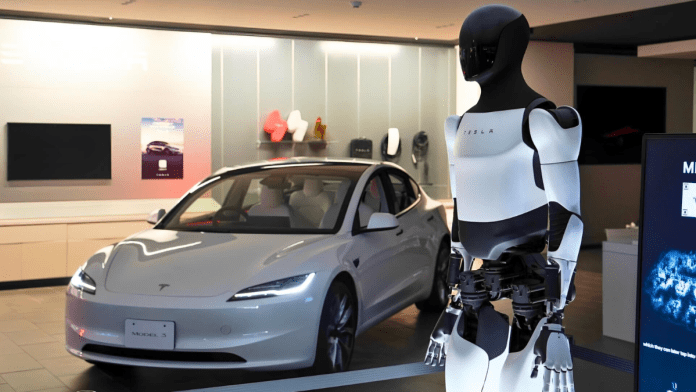🕒 Last updated on July 10, 2025
Tesla is no longer only a car company. It’s building something much bigger—a system that could control real-world robots and machines. This system is being called the “operating system of physical AI.” Just like your phone or computer has an operating system to make everything work together, Tesla is creating one for machines that move, see, and respond to the world around them.
This isn’t science fiction. Tesla is already putting this system to work in its self-driving cars and even in robots. The goal is to allow machines to understand and react to real-life situations without needing help from humans. And Tesla is making everything—chips, software, sensors, and even the robot hardware—on its own.
How Tesla Connects AI to the Real World
Tesla collects massive amounts of data every day from the millions of cars it has on the road. Each car has cameras, sensors, and computer chips that gather information from the world. These cars send that data to Tesla’s computers, where the AI system learns and improves. The next day, Tesla can send updates back to all the cars.
But it doesn’t stop there. Tesla also created a supercomputer called Dojo. This machine is designed to train AI using video and sensor data from the real world. It helps the system understand things like how a person walks, how traffic moves, or even how to sort objects. Tesla’s powerful chips process this information quickly so the AI can learn faster.
This combination of collecting real-world data and training with supercomputers lets Tesla create a system that constantly gets better at understanding the physical world. And because Tesla controls all the parts—from chips to software—it can make everything work together smoothly.
Robots That Think, Move, and Learn
Tesla’s AI doesn’t only live inside cars. The company is building a robot called Optimus. This robot is designed to do physical tasks like lifting boxes or walking around without falling. It uses the same AI system that runs in Tesla cars. That means Optimus can see, understand, and react to the environment just like a Tesla vehicle does.
For example, Optimus has cameras and sensors like a car, but instead of driving, it moves arms and legs. The AI inside tells the robot how to balance, when to pick something up, or where to step next. It learns by watching videos and practicing movements, just like a child learns by doing.
Tesla Warns of Rising Costs and Supply Chain Issues from Tariffs
Tesla updates this robot using the same over-the-air system it uses for cars. So the robot can get smarter and better over time. It’s not just repeating programmed steps. It is actually learning how to move and react in new situations.
What Makes Tesla’s System So Special
Most companies that build robots or smart machines buy parts from other companies. They use chips from one company, software from another, and sensors from someone else. That can make it hard to get everything working well together.
But Tesla builds almost everything in-house. The company makes its own AI chips, trains its AI on its own supercomputers, and updates the system on its own cars and robots. This lets Tesla make changes quickly and test them right away.
Also, Tesla doesn’t just train AI in a lab. It uses real-world information from its cars every day. That means the system learns from real situations like rainy roads, bright sunlight, or people crossing the street. Then, Tesla sends updates to all its devices to make them smarter.
This whole system—the chips, the software, the robots, and the data—is what people are now calling the “operating system of physical AI.” It’s like giving machines a brain and nervous system so they can think, learn, and act in the physical world.
Tesla’s move into physical AI shows how much the company has changed. It’s not only about building electric cars anymore. Now, it’s creating machines that can understand and interact with the real world on their own. From cars that drive themselves to robots that work alongside people, Tesla’s operating system is powering a new kind of intelligence.

